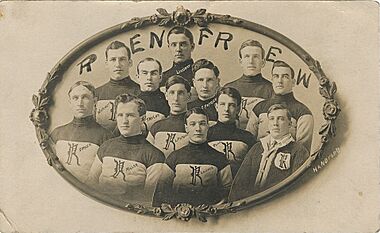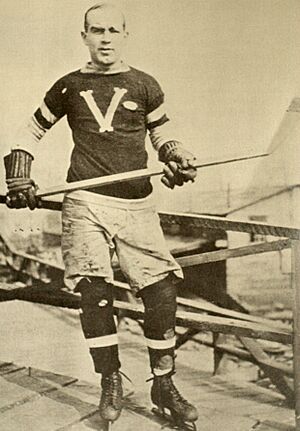Cyclone Taylor facts for kids
Quick facts for kids Cyclone TaylorMBE |
|||
|---|---|---|---|
| Hockey Hall of Fame, 1947 | |||
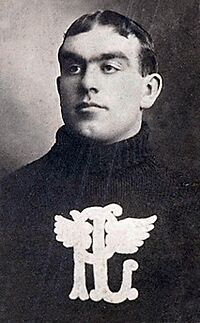
Taylor during his time with the Portage Lakes Hockey Club in 1905
|
|||
| Born | June 23, 1884 Tara, Ontario, Canada |
||
| Died | June 9, 1979 (aged 94) Vancouver, British Columbia, Canada |
||
| Height | 5 ft 8 in (173 cm) | ||
| Weight | 165 lb (75 kg; 11 st 11 lb) | ||
| Position | Rover / Cover-point | ||
| Shot | Left | ||
| Played for | Portage Lakes Hockey Club Ottawa Hockey Club Pittsburgh Athletic Club Renfrew Creamery Kings Vancouver Millionaires Vancouver Maroons |
||
| Playing career | 1906–1922 | ||
Frederick Wellington "Cyclone" Taylor MBE (June 23, 1884 – June 9, 1979) was a famous Canadian ice hockey player. He was also a government worker. Taylor played professionally from 1906 to 1922. Many people say he was one of the first big stars in professional hockey.
He was known as one of the fastest skaters and a great scorer. Taylor won five scoring championships in the PCHA. He also won the Stanley Cup twice: with Ottawa in 1909 and with Vancouver in 1915. In 1947, he was added to the Hockey Hall of Fame.
Taylor was born in Southern Ontario and later moved to Manitoba in 1906 to play hockey. He then played in Houghton, Michigan, for two years in the International Hockey League. This was the first league where players were openly paid. In 1907, he returned to Canada and joined the Ottawa Senators.
During his time in Ottawa, Taylor was compared to baseball star Ty Cobb. In 1909, when Taylor signed with the Renfrew Creamery Kings, he and Cobb were the highest-paid athletes in their sports. In 1912, Taylor moved to Vancouver. He played for the Vancouver Millionaires in the Pacific Coast Hockey Association (PCHA) until 1922.
Besides hockey, Taylor worked as an immigration officer for many years. He started this job in Ottawa in 1907. In 1914, Taylor was the first Canadian official to board the Komagata Maru. This ship was part of a big event about Canadian immigration rules. Taylor eventually became the Commissioner of Immigration for British Columbia and the Yukon. This was the top immigration job in that area.
In 1946, he was given the Order of the British Empire award for his work as an immigration officer. He retired from his government job in 1950.
Contents
Early Life and First Steps in Hockey
Frederick Wellington Taylor was born in Tara, Ontario. He was the second son in a family of five children. Most sources say he was born on June 23, 1884. His father, Archie, was a traveling salesman. Taylor was very close to his mother, who was a Methodist. Because of her, he never smoked, drank, or swore.
When Taylor was six, his family moved to Listowel. His family was not rich. To help out, Taylor left school at 17. He started working in a piano factory. His earnings helped his family.
Taylor started skating on ponds when he was five. He learned to play hockey after moving to Listowel. A local barber, Jack Riggs, taught him. Riggs was known for his speed skating. Taylor joined his first team, the Listowel Mintos, in 1897 when he was 13. He played with them for five years. Even though he was younger, Taylor kept up with the older players. By age sixteen, he was one of the best players and top scorers.
In the 1900–01 season, the Mintos joined the Ontario Hockey Association (OHA). They won their local league championship. In 1904, the team reached the provincial junior championship. They lost in sudden-death overtime. This made Taylor well-known across the province. Many teams wanted him to join them.
In 1903, Taylor was asked to play for the Toronto Marlboros. But Taylor was happy in Listowel with his family and job. He said no to the offer. This made the OHA secretary, Bill Hewitt, angry. The OHA controlled player moves to keep players from changing teams too often. Because Taylor refused to join the Marlboros, he was not allowed to play anywhere else in Ontario. Hewitt banned Taylor from playing hockey in Ontario for the 1903–04 season. Taylor tried to join a team in Thessalon, Ontario, in 1904, but was still not allowed. So, he did not play during the 1904–05 season.
Hockey Career Highlights
Playing in Portage and Michigan (1906–1907)
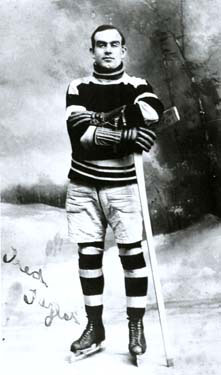
Taylor was frustrated after sitting out a whole season. So, in January 1906, he moved to Portage la Prairie, Manitoba. He joined a team there for the 1905–06 season. At that time, hockey in Canada was amateur. Taylor was offered a place to live, food, and $25 a month. In his first game, Taylor scored two goals. He impressed everyone with his skills.
After a game against the Kenora Thistles, Taylor was asked to join them. They were going to challenge for the Stanley Cup. While thinking about it, Taylor was approached by the Portage Lakes Hockey Club. This was a professional team in Houghton, Michigan. They were part of the International Professional Hockey League (IHL). The IHL was the first openly professional hockey league. Taylor was offered US$400 plus expenses. He agreed to join.
In February, Taylor left Portage la Prairie for Houghton. He played as a cover-point (an early type of defenceman). He scored eleven goals in six games. His team won the 1906 IHL championship. The next season, 1906–07, Taylor scored 14 goals in 23 games. Portage Lakes won the league title again. Taylor enjoyed his time in the IHL. He said it was a great place to learn and improve.
The IHL paid high salaries, attracting many top Canadian players. In 1907, the Eastern Canada Amateur Hockey Association (ECAHA) in Canada decided to allow professional players. Many Canadian players returned home, and the IHL closed that summer. Taylor went back to Listowel for the summer of 1907. He played lacrosse and listened to offers from hockey teams. Teams like the Quebec Bulldogs and Montreal Wanderers wanted him.
Joining the Ottawa Senators (1907–1909)
In Portage La Prairie they called him a tornado, in Houghton, Michigan, he was known as a whirlwind. From now on he'll be known as Cyclone Taylor.
Taylor signed with the Ottawa Senators. They played in the ECAHA. The Senators offered him $500 for the season. This was a good salary for that time. What really interested Taylor was a job offer. The club promised him a position in the immigration branch of the federal government. Taylor liked the idea of a steady career after hockey. He started as a junior clerk, earning $35 a month.
Soon after arriving in Ottawa, other teams tried to get Taylor. The Renfrew Creamery Kings offered him $1,500 for the season. Taylor visited Renfrew and almost signed with them. But the Senators convinced him to stay.
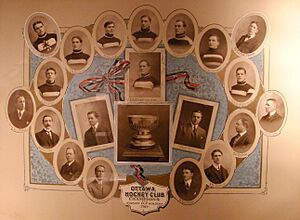
Taylor played centre for the Senators in his first game of the season. He was 5 feet 8 inches tall and weighed 165 pounds. He was one of the fastest players. He was often called offside because he was too quick for his teammates. So, he moved to cover-point. This position let him use his speed better.
Later that season, the Governor General of Canada, Earl Grey, watched a game. He reportedly said, "That new No. 4, Taylor, he's a cyclone if ever I saw one." This was because of Taylor's speed. Before this, he was called a "tornado" or "whirlwind." But "Cyclone" stuck with him. Taylor played well, scoring nine goals in eleven games. He was named the best cover-point in the ECAHA.
At the start of the 1908–09 season, Taylor briefly signed with the Pittsburgh Athletic Club. But after three games, they released him. Taylor decided to return to Ottawa for the season. He played 11 games and scored 9 goals. The Senators won the league championship. They were awarded the Stanley Cup.
Renfrew Creamery Kings (1909–1912)
Before the 1909–10 season, Taylor was again wanted by Renfrew. On December 30, Taylor signed with the Renfrew Creamery Kings. His salary was reported to be as high as $5,250 for the season. This would have made him the highest-paid athlete in Canadian history. He was compared to baseball player Ty Cobb, who earned $6,500.
Taylor was interested in Renfrew because they were building a strong team. They were willing to pay for top players. Shortly before he signed, they added brothers Lester and Frank Patrick. Other great players like Bert Lindsay and Herb Jordan also joined. The team was later joined by Newsy Lalonde. With so many high-priced players, the team was called the "Millionaires."
Even with all the talent, Renfrew finished third in their league. They could not challenge for the Stanley Cup. Taylor scored ten goals in twelve games. During this season, a famous story about Taylor began. Before a game against Ottawa, Taylor said he would score a goal while skating backward. He didn't score in that game. But in the next game, he scored three goals, including one while skating backward!
Taylor re-signed with Renfrew for the 1910–11 season. His salary dropped to $1,800. The Patrick brothers moved west. Lalonde joined the Montreal Canadiens. A weaker Renfrew team again finished third. Taylor scored twelve goals in sixteen games.
Renfrew stopped playing before the 1911–12 season. Other teams claimed its players. Taylor was claimed by the Montreal Wanderers. But Taylor refused to play in Montreal. He said he would only play for Ottawa or not at all. So, he sat out the season. The Senators still paid him $1,200, hoping he would join them later. Taylor played a few games and worked as a referee in a local league.
Vancouver Millionaires (1912–1922)
Lester and Frank Patrick had moved to Western Canada. They started a new professional league, the Pacific Coast Hockey Association (PCHA). They recruited players from Eastern Canada.
After the 1911–12 season, the Wanderers gave up on signing Taylor. He turned down a $3,000 contract from the Toronto Tecumsehs. He also turned down an $1,800 offer from Ottawa. Taylor talked with the Patricks for months. He finally agreed to join the Vancouver Millionaires. This was announced on November 20. He was given a salary of $2,200. This made Taylor the highest-paid player in hockey again. Taylor did not sign a written contract. He said it was "just a verbal agreement."
Taylor's presence made the PCHA more popular. The Millionaires sold out their first home game of the 1912–13 season. This was Taylor's first game in the league. Before that game, Taylor had bad stomach pains. He almost missed the game. But he played and scored in a 7–2 Vancouver win. The pain turned out to be appendicitis. He played all sixteen games that season. He finished with ten goals and eight assists. The PCHA was the first league to officially track assists.
Becoming a Rover
The next season, Taylor changed positions to rover. This position combined both offense and defense. He played as a rover for the rest of his career. This change helped Taylor lead the PCHA in scoring. He had 39 points in 16 games. He also tied for the goal-scoring title with 24 goals. Taylor was the scoring leader again in 1914–15. He had 45 points in 16 games.
Vancouver finished first in the league. They earned the right to play for the Stanley Cup. Starting in 1914, the Stanley Cup was played between the PCHA and the NHA champions. The 1915 Final was in Vancouver. The NHA champions were the Ottawa Senators. Vancouver won the first three games to win the Cup. Taylor scored eight goals and two assists.
Taylor won the PCHA scoring title again in 1915–16. He had 35 points in 18 games. Vancouver finished second and could not defend their Stanley Cup title. After this season, Taylor said he would retire. But he was convinced to return for the 1916–17 season. He started strong, but his appendicitis returned. He had surgery to remove his appendix. He played in 12 games and finished with 29 points.
In the 1917–18 season, Taylor was healthy. He played in 18 games. He led the league in goals (32) and points (43). He was named the most valuable player of the league. Vancouver won the PCHA championship. They traveled to Toronto to play the National Hockey League (NHL) champion, the Toronto Arenas. This was for the 1918 Stanley Cup Finals. Taylor scored the most goals in the series (9). But Toronto won the Cup. Taylor was the PCHA scoring champion again in 1918–19. He led in goals (23), assists (13), and points (36). This was his fifth and final time leading the PCHA in scoring.
After the season, Taylor said he would retire again. But he returned for the 1919–20 season. A leg injury limited him to ten games. He recorded twelve points. He announced his retirement a third time. However, Frank Patrick convinced him to play only home games as a replacement player during the 1920–21 season. Taylor had five goals and one assist in six games. He played in three games of the Stanley Cup Final against the Senators. Ottawa won the Cup. Taylor decided to retire again. He sat out the 1921–22 season. But he tried to return for the 1922–23 season. He played one game with Vancouver (now called the Maroons) on December 8, 1922. He realized he couldn't keep up. Taylor decided to finally quit hockey after that one game.
After His Playing Career
Taylor stayed involved in hockey. He was the first president of the Pacific Coast Hockey League from 1936 to 1940. In 1970, he dropped the puck for the first home game of the Vancouver Canucks. He was a season-ticket holder and attended Canucks games until he passed away.
Life Beyond Hockey
Immigration Officer Role
In October 1907, Taylor joined the Immigration Branch of the federal government. The Ottawa Senators helped arrange this job. Taylor liked the idea of a government job. He saw it as a way to have a secure career after hockey. He started as a junior clerk.
When Taylor moved to Vancouver in 1912, he took time off from his job. Frank Patrick helped Taylor get his job transferred to Vancouver. He also helped Taylor get promoted to senior immigration inspector.
By 1914, Taylor was in charge of traffic at the port of Vancouver. He boarded ships and checked passenger lists. This is how he became involved in the Komagata Maru incident. The Komagata Maru was a ship carrying 376 Sikh, Muslim, and Hindu immigrants from India. They were trying to enter Canada. The ship arrived in Vancouver on May 23, 1914. Taylor was the first immigration officer to board it.
Taylor spent a lot of time on the ship while it was in Vancouver harbour. The passengers were not allowed to leave or get more supplies. Taylor watched over everyone until the ship left for India on July 23. The passengers were not allowed into Canada. Taylor later said it "was a terrible affair, and nobody was proud of it."
When World War I started in August 1914, Taylor joined the Canadian Army. But immigration officials were soon seen as essential workers. So, Taylor was released from the military. He spent the war working in Vancouver.
After retiring from hockey, Taylor kept his immigration job. He eventually became the Commissioner of Immigration for British Columbia and the Yukon. This was the highest position in the region. In 1946, Taylor was named a Member of the Order of the British Empire. This was for his great service as an immigration officer during two wars. He retired from government service in 1950.
Personal Life and Family
Taylor was raised a Methodist. He never drank, smoked, or swore. He said these values came from his mother's strong faith. His family supported the Conservative Party. It was unusual for a Conservative supporter to get a federal job when the Liberal Party was in power.
In 1908, Taylor helped start a Scout troop in Ottawa. This began his lifelong involvement with the Scouting movement. In Vancouver, he also worked actively with the YMCA. Taylor was known for being well-spoken and polite. He was also always well-dressed. Taylor was also a Freemason.
Taylor enjoyed other sports, especially lacrosse. He played lacrosse during the summers of his hockey career. In 1908, he joined the Ottawa Capitals lacrosse team. During one game, Taylor accidentally punched the referee. Police arrested him, but the referee explained it was an accident. League officials considered banning Taylor. But they let him play because he attracted large crowds. In 1914, he played for the Vancouver Terminals, earning $50 per game.
In February 1908, Taylor met Thirza Cook. She worked as a secretary in the Immigration Department. Thirza's mother was from a wealthy family. She was not impressed with Taylor's background. She also didn't like her daughter being with a hockey player. Taylor decided to save $10,000 to prove himself. He earned $2,800 a year from his two jobs. It took him six years to reach his goal.
Taylor and Cook were married on March 19, 1914, in Ottawa. Frank Patrick was the best man. They went to New York for their honeymoon. The couple then moved to Vancouver. Thirza passed away in March 1963.
Taylor had three sons and two daughters. His second oldest son, John, also played hockey. He won two Canadian university championships. John turned down a contract from the Toronto Maple Leafs to become a lawyer. He worked in immigration law before becoming a politician. John was elected to the House of Commons in 1957.
In 1957, Taylor's oldest son, Fred Jr., opened a chain of sporting-goods stores. He named them Cyclone Taylor Sports after his father. A grandson, Mark Taylor, played in the NHL from 1981 to 1986. Taylor's youngest child, Joan, passed away in 1976. After breaking his hip in 1978, Taylor's health declined. He passed away in his sleep in Vancouver on June 9, 1979.
Cyclone Taylor's Legacy
Taylor was seen as one of the best hockey players of his time. He is considered the first big star of the professional hockey era. When he went to play in Pittsburgh in 1908, newspapers noted that he could get "almost anything he asked for." When he left Ottawa for Vancouver in 1912, the Ottawa Citizen called him "the greatest drawing card in the game." Taylor was known for his speed and creativity. Teams wanted him because he helped sell more tickets. He always had many teams interested in him. This allowed him to earn some of the highest salaries of his time.
In 1947, Taylor was elected into the Hockey Hall of Fame. He was also inducted into the Canadian Sports Hall of Fame and the British Columbia Sports Hall of Fame. When the Hockey Hall of Fame started building a new home in 1961, Taylor was given the honor of turning the first bit of soil.
Several awards are named after Taylor. The Vancouver Canucks team award for most valuable player is called the Cyclone Taylor Trophy. Since 1966, the Cyclone Taylor Cup has been awarded to the champion of a tournament for British Columbia Junior B hockey leagues. The junior team in Taylor's hometown, the Listowel Cyclones, is named after him.
Career Statistics
Regular Season and Playoffs
| Regular season | Playoffs | |||||||||||||||
|---|---|---|---|---|---|---|---|---|---|---|---|---|---|---|---|---|
| Season | Team | League | GP | G | A | Pts | PIM | GP | G | A | Pts | PIM | ||||
| 1905–06 | Portage la Prairie | MHL | 4 | 3 | 1 | 4 | 0 | — | — | — | — | — | ||||
| 1905–06 | Portage Lakes | IHL | 6 | 11 | 0 | 11 | 4 | — | — | — | — | — | ||||
| 1906–07 | Portage Lakes | IHL | 23 | 18 | 7 | 25 | 31 | — | — | — | — | — | ||||
| 1907–08 | Ottawa Senators | ECAHA | 10 | 9 | 0 | 9 | 40 | — | — | — | — | — | ||||
| 1908–09 | Pittsburgh Athletic Club | WPHL | 3 | 0 | 0 | 0 | 0 | — | — | — | — | — | ||||
| 1908–09 | Ottawa Senators | ECHA | 11 | 9 | 0 | 9 | 28 | — | — | — | — | — | ||||
| 1909–10 | Renfrew Creamery Kings | NHA | 13 | 10 | 0 | 10 | 19 | — | — | — | — | — | ||||
| 1910–11 | Renfrew Creamery Kings | NHA | 16 | 12 | 0 | 12 | 21 | — | — | — | — | — | ||||
| 1911–12 | NHA All-Stars | Exhib. | 3 | 0 | 0 | 0 | 3 | — | — | — | — | — | ||||
| 1912–13 | Vancouver Millionaires | PCHA | 14 | 10 | 8 | 18 | 5 | — | — | — | — | — | ||||
| 1913–14 | Vancouver Millionaires | PCHA | 16 | 24 | 15 | 39 | 18 | — | — | — | — | — | ||||
| 1914–15 | Vancouver Millionaires | PCHA | 16 | 23 | 22 | 45 | 9 | — | — | — | — | — | ||||
| 1914–15 | Vancouver Millionaires | St-Cup | — | — | — | — | — | 3 | 8 | 2 | 10 | 3 | ||||
| 1915–16 | Vancouver Millionaires | PCHA | 18 | 22 | 13 | 35 | 9 | — | — | — | — | — | ||||
| 1916–17 | Vancouver Millionaires | PCHA | 12 | 14 | 15 | 29 | 12 | — | — | — | — | — | ||||
| 1917–18 | Vancouver Millionaires | PCHA | 18 | 32 | 11 | 43 | 0 | 2 | 0 | 1 | 1 | 0 | ||||
| 1917–18 | Vancouver Millionaires | St-Cup | — | — | — | — | — | 5 | 9 | 0 | 9 | 15 | ||||
| 1918–19 | Vancouver Millionaires | PCHA | 20 | 23 | 13 | 36 | 12 | 2 | 1 | 0 | 1 | 0 | ||||
| 1919–20 | Vancouver Millionaires | PCHA | 10 | 6 | 6 | 12 | 0 | 2 | 0 | 0 | 0 | 0 | ||||
| 1920–21 | Vancouver Millionaires | PCHA | 6 | 5 | 1 | 6 | 0 | 2 | 0 | 0 | 0 | 0 | ||||
| 1920–21 | Vancouver Millionaires | St-Cup | — | — | — | — | — | 3 | 0 | 1 | 1 | 5 | ||||
| 1922–23 | Vancouver Maroons | PCHA | 1 | 0 | 0 | 0 | 0 | — | — | — | — | — | ||||
| NHA totals | 29 | 22 | 0 | 22 | 40 | — | — | — | — | — | ||||||
| PCHA totals | 130 | 159 | 104 | 263 | 65 | 8 | 1 | 1 | 2 | 0 | ||||||
| Stanley Cup totals | — | — | — | — | — | 11 | 17 | 3 | 20 | 23 | ||||||
| Source: Total Hockey | ||||||||||||||||
Awards and Achievements
| Award | Year(s) |
|---|---|
| PCHA Scoring Champion | 1913–14, 1914–15, 1915–16, 1917–18, 1919 |
| PCHA All-Star Team | 1914, 1915 |
| PCHA Most Valuable Player | 1918 |
| Stanley Cup Champion | 1909, 1915 |


